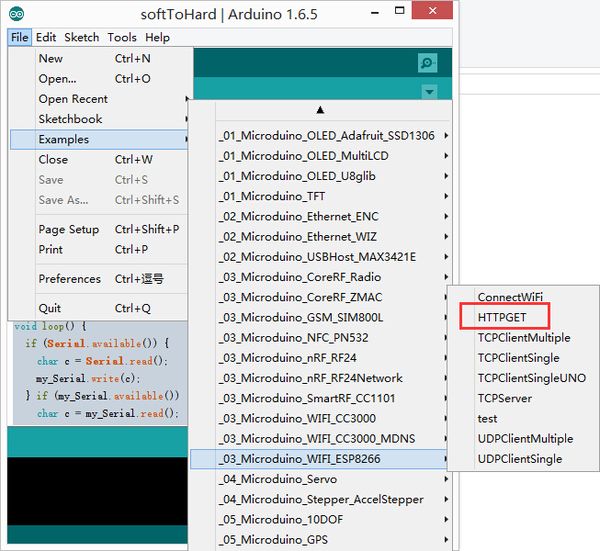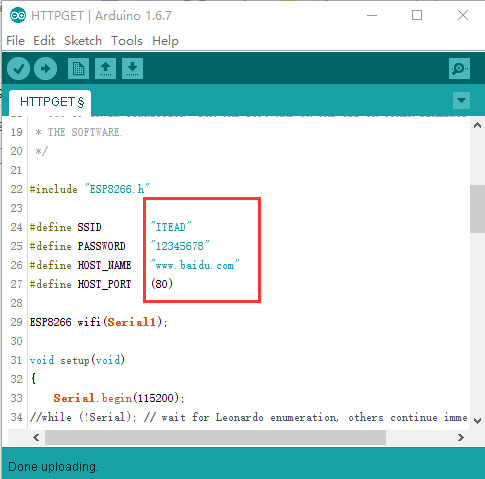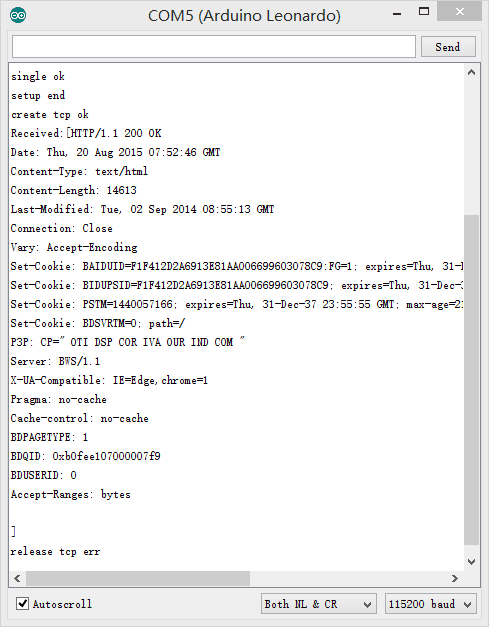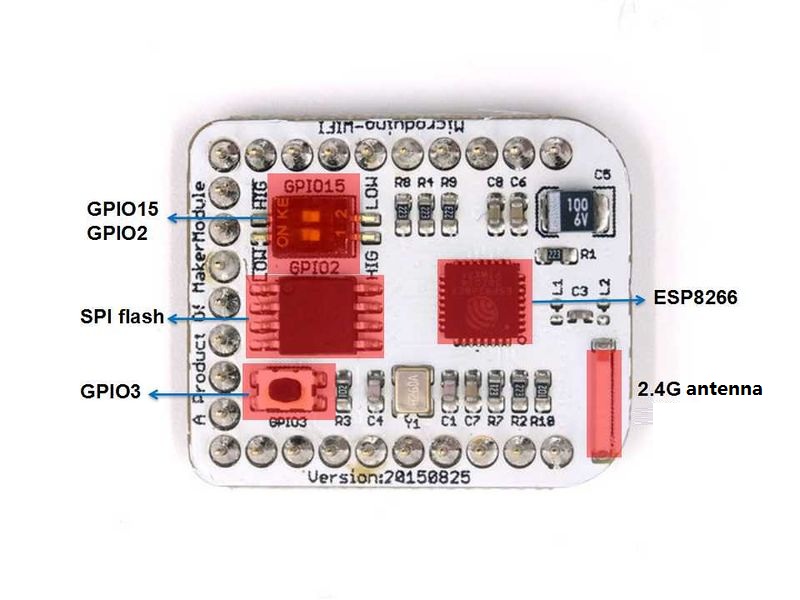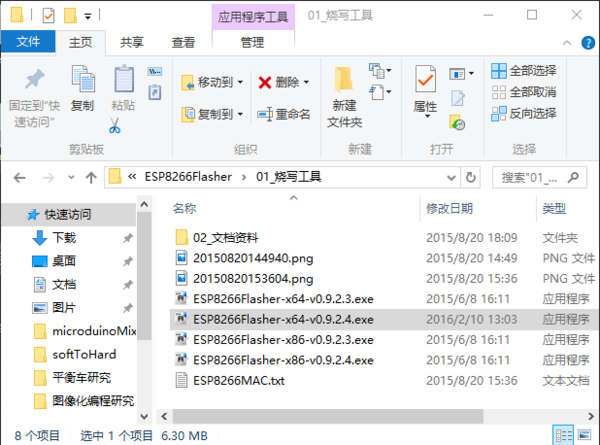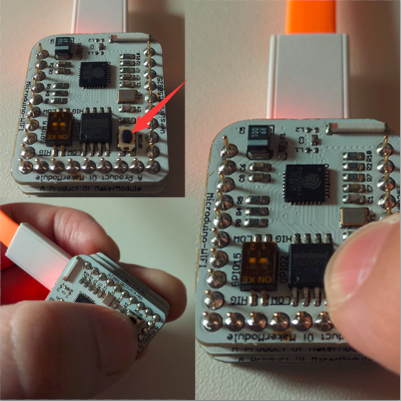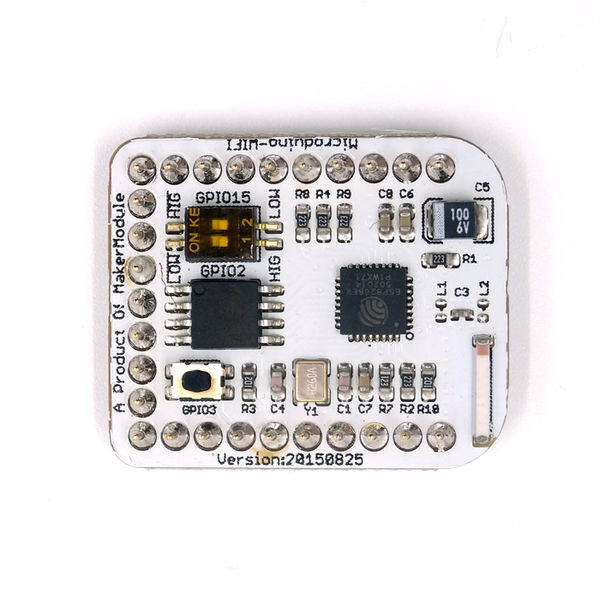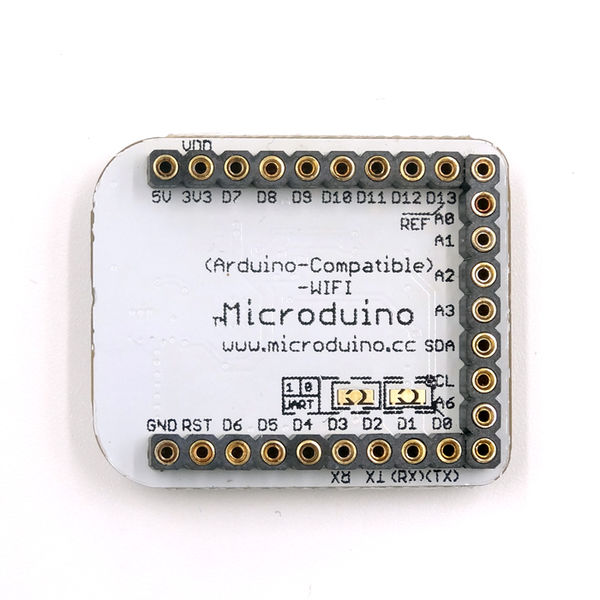Difference between revisions of "Microduino-Module WIFI,ESP"
(→Modules Connection) |
|||
| (6 intermediate revisions by 3 users not shown) | |||
| Line 4: | Line 4: | ||
| | | | ||
[[file:Microduino-8266-rect.jpg|400px|thumb|right|Microduino-ESP]] | [[file:Microduino-8266-rect.jpg|400px|thumb|right|Microduino-ESP]] | ||
| − | Microduino-WIFI(ESP) is a WIFI communication module, which can communicate with | + | Microduino-WIFI(ESP) is a WIFI communication module, which can communicate with Core+/CoreUSB (Core can not be used, because its baud rate can't reach at 115200.) through the serial port or connect with other WIFI devices and is a complete and system-in-itself wifi network resolution. |
==Features== | ==Features== | ||
*Serial communication. | *Serial communication. | ||
*Internet connection available. | *Internet connection available. | ||
| − | *Small, cheap, | + | *Small, cheap, stack-able and open. |
*High on-chip integration. | *High on-chip integration. | ||
*Have a strong on-chip processing and storage capabilities. | *Have a strong on-chip processing and storage capabilities. | ||
*Reduce the occupancy of system resources in operation. | *Reduce the occupancy of system resources in operation. | ||
| − | *Available for integrating | + | *Available for integrating sensor and other application specific devices through the GPIO port. |
==Specification== | ==Specification== | ||
| − | *Communication method: Serial | + | *Communication method: Serial pass through with the default serial port D2(RX), D3(TX); |
*Power supply: +3.3VDC 50mA; | *Power supply: +3.3VDC 50mA; | ||
*Status indicator; | *Status indicator; | ||
| Line 101: | Line 101: | ||
*Programming tool:'''[[File:ESP8266Flasher.rar]]''' | *Programming tool:'''[[File:ESP8266Flasher.rar]]''' | ||
*Firmware:'''[[File:MicroduinoESP8266.rar]]''' | *Firmware:'''[[File:MicroduinoESP8266.rar]]''' | ||
| + | |||
| + | You can use English Flasher see http://www.xess.com/blog/esp8266-reflash/ with Firmware MicroduinoESP8266 binary | ||
===Modules Connection=== | ===Modules Connection=== | ||
*Before programming, you need to prepare the serial port environment of the WIFI module. | *Before programming, you need to prepare the serial port environment of the WIFI module. | ||
| − | *The serial port the WIFI module uses is serial port | + | *The serial port the WIFI module uses is serial port 1(D2, D3), so there are two methods of connect: |
*Method A: Use USBTTL to transform through the serial port. | *Method A: Use USBTTL to transform through the serial port. | ||
**For cables are needed to connect the serial ports together. | **For cables are needed to connect the serial ports together. | ||
| Line 150: | Line 152: | ||
===Function Verification=== | ===Function Verification=== | ||
| − | * | + | *3: After downloading, powered again, it can work normally. |
*Open the serial port debugging tool, and test the AT command to confirm whether the downloading is successful or not. | *Open the serial port debugging tool, and test the AT command to confirm whether the downloading is successful or not. | ||
| Line 157: | Line 159: | ||
==Players Community== | ==Players Community== | ||
| − | At present, there are many playing methods of ESP8266 , and according to the different kinds of the firmware, they can be roughly divided | + | At present, there are many playing methods of ESP8266, and according to the different kinds of the firmware, they can be roughly divided into: |
| − | *1 | + | *1. AT firmware method is using Arduino mcu combining with ESP8266 brushed with the AT command to implement the internet of things; |
| − | *2 | + | *2. NodeMCU firmware method refers to brush ESP8266 firmware to NodeMCU, then use Arduino IDE for ESP8266 to compile program and brush to the corresponding flash zone to implement the control. Besides, this firmware can also be compile program with NodeMcu Studio 2015 or LuaLoader, in LUA language , to implement the internet of things; |
| − | *3 | + | *3. SDK method refers to use sdk provided by such as Lexin, Essence and Guoyun Techonology to build project, which combines with eclipse and cygwin to generate the firmware programming. And the language this method adopts are c and c++. At present, GizWits, HEKR and tisan in our country are all implemented by this method. |
| − | *4 | + | *4. Micropython method is similar to the front one. Use Micropython SDK to compile and program firmware, and then use putty or other serial port software to run the program on the basis of python language. |
From:http://www.geek-workshop.com/forum.php?mod=viewthread&tid=25456&page=1&extra=#pid114413 | From:http://www.geek-workshop.com/forum.php?mod=viewthread&tid=25456&page=1&extra=#pid114413 | ||
Latest revision as of 05:58, 4 August 2017
| Language: | English • 中文 |
|---|
|
Microduino-WIFI(ESP) is a WIFI communication module, which can communicate with Core+/CoreUSB (Core can not be used, because its baud rate can't reach at 115200.) through the serial port or connect with other WIFI devices and is a complete and system-in-itself wifi network resolution. ContentsFeatures
Specification
Common AT Instruction
Documents
Development
Use Microduino IDE-->example-->_03_microduino_WiFi_ESP8266-->HTTPGET program test is OK. You can change the WIFI password where you set the SSID (WIFI name) and the password in the code.
insert USB line into the Microduino-USBttl, other side of USB line insert into computer, start Arduino IDE, The above program is copied to the IDE, the tool (tools) -> Board (Board) is selected Microduino Core, and the tools (tools) -> Serial Port (Serial) select the corresponding serial number. After clicking the top left corner IDE √ button to compile the program, after the end of the compilation click -> button is programmed to the board;
Application
Firmware ProgrammingDownload the Programming Tool
You can use English Flasher see http://www.xess.com/blog/esp8266-reflash/ with Firmware MicroduinoESP8266 binary Modules Connection
void setup() {
Serial.begin(115200);
Serial1.begin(115200);
}
void loop() {
if (Serial.available()) {
char c = Serial.read();
Serial1.write(c);
} if (Serial1.available()) {
char c = Serial1.read();
Serial.write(c);
}
}Configure Programming Tool
Programming
Function Verification
FAQPlayers CommunityAt present, there are many playing methods of ESP8266, and according to the different kinds of the firmware, they can be roughly divided into:
From:http://www.geek-workshop.com/forum.php?mod=viewthread&tid=25456&page=1&extra=#pid114413 Gallery |

